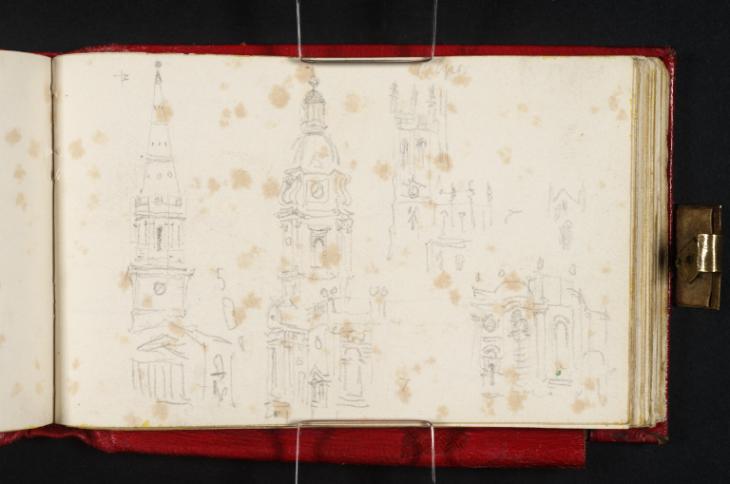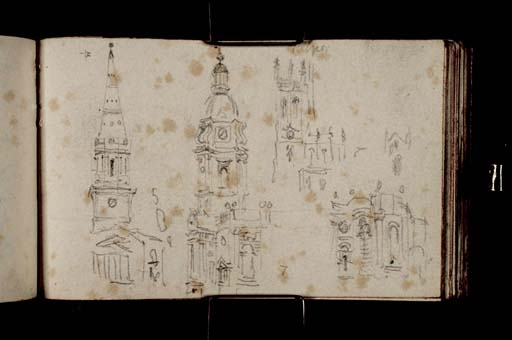Joseph Mallord William Turner Birmingham Church Towers: Christ Church, St Philip's and St George's Hockley 1830
Image 1 of 2
Joseph Mallord William Turner,
Birmingham Church Towers: Christ Church, St Philip's and St George's Hockley
1830
Joseph Mallord William Turner 1775–1851
Folio 38 Verso:
Birmingham Church Towers: Christ Church, St Philip’s and St George’s Hockley 1830
D22394
Turner Bequest CCXL 38a
Turner Bequest CCXL 38a
Pencil on white wove paper, 68 x 110 mm
Partial watermark ‘[Prince of Wales feathers]’
Inscribed by Turner ‘[?Philips]’ top centre, ‘5’ left of centre and ‘7’ bottom centre
Partial watermark ‘[Prince of Wales feathers]’
Inscribed by Turner ‘[?Philips]’ top centre, ‘5’ left of centre and ‘7’ bottom centre
Accepted by the nation as part of the Turner Bequest 1856
References
1909
A.J. Finberg, A Complete Inventory of the Drawings of the Turner Bequest, London 1909, vol.II, p.739, CCXL 38a, as ‘Churches; probably at Birmingham’.
Three church towers from different parts of Birmingham are brought together here, inverted relative to the sketchbook’s foliation. On the left are the classical spire, tower and portico of Christ Church; demolished in 1899,1 it stood on the site of Victoria Square, latterly west of the Town Hall and south of the Art Gallery. There is a detail of its weathervane at the top left. At the centre and lower right are the Baroque cupola, dome and tower and the main body of St Philip’s Church (later Birmingham Cathedral), built to Thomas Archer’s design between 1711 and 1725;2 Turner has only drawn the first of the seven bays along its flat south side, noting ‘7’ at this point, before moving a little to the right to record the apsidal east end. As part of unpublished Turner research informed by local knowledge, Dr Bernard Richards identified the building at the top right as the Gothic St George’s Hockley, north-west of central Birmingham, seen from the south;3 it was built to a design by Thomas Rickman in 1819 and demolished in 1961.4
The overall subject had been confirmed as Birmingham (identifying ‘the centre one’ as St Philip’s) by A.J. Finberg (died 1939) and the watercolour and Turner scholar C.F. Bell (died 1966) in undated manuscript notes in copies of Finberg’s 1909 Inventory.5 For other Birmingham views, see under folio 3 recto (D22327).
See William Dargue, ‘Christ Church, New Street’, A History of Birmingham Churches ... from A to Y, accessed 9 July 2013, http://ahistoryofbirminghamchurches.jimdo.com/birmingham-st-martin-in-the-bull-ring/christ-church-new-street/ .
See William Dargue, ‘St Philip’s, Birmingham Cathedral’, A History of Birmingham Churches ... from A to Y, accessed 9 July 2013, http://ahistoryofbirminghamchurches.jimdo.com/birmingham-st-martin-in-the-bull-ring/st-philip-s-birmingham-cathedral/
See William Dargue, ‘Hockley, St George’, A History of Birmingham Churches ... from A to Y, accessed 9 July 2013, http://ahistoryofbirminghamchurches.jimdo.com/birmingham-st-martin-in-the-bull-ring/st-george-hockley/
Technical notes:
This leaf is affected by the extensive pale brown, mottled staining which extends throughout this particular gathering (folios 31–42; D22379–D22402) and also folios 30 and 43 recto and verso (D22377, D22378, D22403, D22404), as discussed in the Technical notes to the sketchbook’s Introduction.
Matthew Imms
August 2013
How to cite
Matthew Imms, ‘Birmingham Church Towers: Christ Church, St Philip’s and St George’s Hockley 1830 by Joseph Mallord William Turner’, catalogue entry, August 2013, in David Blayney Brown (ed.), J.M.W. Turner: Sketchbooks, Drawings and Watercolours, Tate Research Publication, September 2014, https://www


